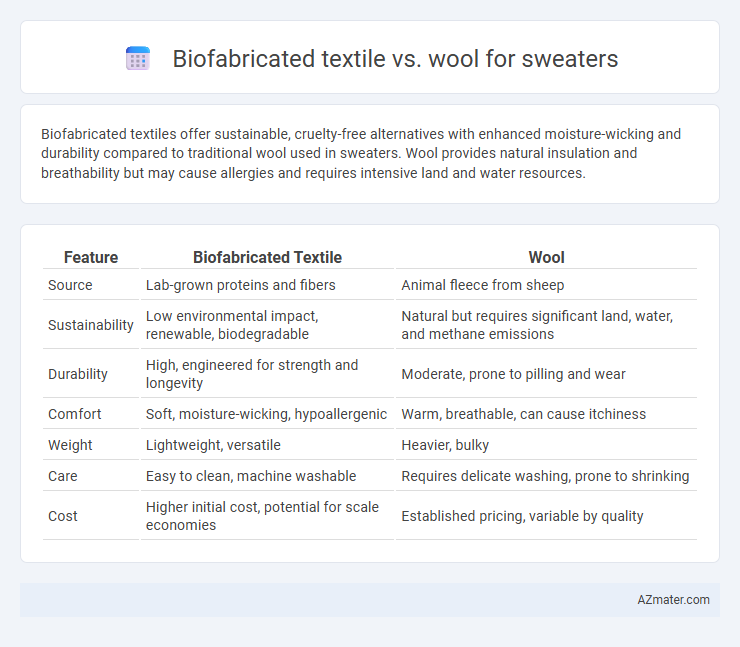Biofabricated textiles offer sustainable, cruelty-free alternatives with enhanced moisture-wicking and durability compared to traditional wool used in sweaters. Wool provides natural insulation and breathability but may cause allergies and requires intensive land and water resources.
Table of Comparison
| Feature | Biofabricated Textile | Wool |
|---|---|---|
| Source | Lab-grown proteins and fibers | Animal fleece from sheep |
| Sustainability | Low environmental impact, renewable, biodegradable | Natural but requires significant land, water, and methane emissions |
| Durability | High, engineered for strength and longevity | Moderate, prone to pilling and wear |
| Comfort | Soft, moisture-wicking, hypoallergenic | Warm, breathable, can cause itchiness |
| Weight | Lightweight, versatile | Heavier, bulky |
| Care | Easy to clean, machine washable | Requires delicate washing, prone to shrinking |
| Cost | Higher initial cost, potential for scale economies | Established pricing, variable by quality |
Introduction to Biofabricated Textiles and Wool
Biofabricated textiles are engineered from living cells or microbes, creating sustainable and customizable materials that reduce environmental impact compared to traditional fibers. Wool, derived from sheep fleece, offers natural insulation, moisture-wicking, and biodegradability but involves higher resource consumption and animal welfare concerns. Comparing these fibers highlights biofabricated textiles as innovative alternatives aiming to balance performance, sustainability, and ethical production in sweater manufacturing.
Origins and Production Processes
Biofabricated textiles are created using microbial fermentation or cell culture techniques, enabling the production of fibers without relying on traditional farming. Wool is sourced from sheep through shearing, which involves animal husbandry and land use. The biofabrication process emphasizes sustainability and reduced environmental impact, while wool production depends on livestock management and natural fiber growth cycles.
Material Properties and Comfort
Biofabricated textiles offer superior moisture-wicking and breathability compared to wool, making sweaters more comfortable in varying temperatures. Wool excels in insulation and natural odor resistance, providing warmth and durability ideal for cold climates. Both materials exhibit elasticity and resilience, but biofabricated textiles often allow for customization in texture and weight to enhance wearer comfort.
Environmental Impact Comparison
Biofabricated textiles offer a significantly lower environmental impact compared to wool, reducing land use, water consumption, and greenhouse gas emissions by up to 90%. Wool production involves methane emissions from sheep and requires extensive grazing land, contributing to soil degradation and biodiversity loss. Sustainable biofabrication methods minimize reliance on animal agriculture, promoting a more circular and resource-efficient textile industry.
Ethical and Animal Welfare Considerations
Biofabricated textiles offer a cruelty-free alternative to wool by eliminating the need for sheep shearing and reducing animal exploitation. These lab-grown fibers minimize environmental stress associated with traditional wool production, such as overgrazing and methane emissions from livestock. Choosing biofabricated textiles supports sustainable fashion practices that prioritize animal welfare and ethical manufacturing processes.
Durability and Longevity
Biofabricated textiles exhibit enhanced durability and longevity due to their engineered fiber structure, resisting wear and tear better than traditional wool. Wool fibers, while naturally resilient and moisture-wicking, tend to degrade faster with repeated washing and UV exposure. The advanced molecular composition of biofabricated textiles ensures sustained fabric strength and shape retention, making them superior for long-term sweater use.
Aesthetic and Style Differences
Biofabricated textiles offer a sleek, futuristic aesthetic characterized by uniform textures and customizable colors that appeal to modern, eco-conscious fashion. Wool sweaters showcase natural variations in texture and color, providing a timeless, cozy look with inherent warmth and breathability. The stylistic contrast lies in biofabricated textiles' smooth, innovative appearance versus wool's traditional, organic charm.
Cost and Market Availability
Biofabricated textiles currently have higher production costs compared to traditional wool, making them less accessible for mass-market sweater manufacturing. Wool benefits from an established global supply chain, ensuring widespread availability and more competitive pricing. Despite limited market presence, biofabricated textiles offer potential for scalable production, which could reduce costs as technology advances.
Consumer Perceptions and Preferences
Consumers increasingly favor biofabricated textiles over wool for sweaters due to sustainability concerns and animal welfare awareness, perceiving biofabricated options as eco-friendly and cruelty-free. Wool maintains appeal for its natural warmth and breathability, but some consumers associate it with ethical issues and allergenic potential. Preferences heavily depend on values related to environmental impact, comfort, and product innovation.
Future Trends in Sweater Materials
Biofabricated textiles offer sustainable, cruelty-free alternatives to traditional wool, leveraging lab-grown materials that mimic natural fibers while reducing environmental impact. Innovations in biofabrication emphasize scalability and enhanced performance properties like moisture-wicking and thermal regulation, positioning these textiles as key players in the future sweater market. As consumer demand shifts toward eco-conscious fashion, biofabricated textiles are expected to disrupt conventional wool usage by combining ethical production with cutting-edge material science.

Infographic: Biofabricated textile vs Wool for Sweater
 azmater.com
azmater.com